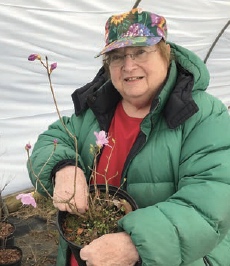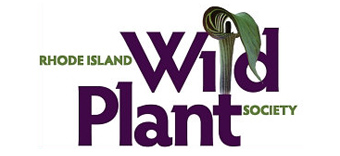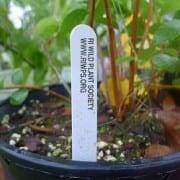By Sue Theriault
This article first appeared in our publications WildfloraRI, Fall 2021

Sandra Thompson (photo ARaver)
The loss of our dear colleague and long-time plant sale coordinator Sandra Thompson prompted me to reflect on the evolution of RIWPS’ plant sale through the years. Sandra was passionate about the propagation and sale of native plants and has left her mark on both Seed Starters East and what has become known as the “Best Native Plant Sale in Rhode Island.” With her loss, it feels like Seed Starters East and the plant sale are beginning a new chapter.
But to look ahead, it helps to first look back. And who better to help do this than board member Dorothy Swift, a founding member of both RIWPS and Seed Starters East. Dorothy was the first program chair when the organization began in 1987, and soon after Lisa Gould, the society’s first president, accepted an invitation by the URI Cooperative Extension to host an information booth at their Spring and Fall Festivals. They saw it as a chance to promote the fledgling organization, to hand out information on native plants, and to sell a few plants that RIWPS’ volunteers shared from their gardens — some plants were native to RI, some native to other places, and some cultivated perennials. Thus, the plant sale was born!
Early on, Dorothy had an idea for a seed propagation program. Dorothy was no stranger to propagation; she had grown rhododendrons through tissue culture and cuttings with Mike Medeiros at Plane View Nursery. But she wanted to try seeds and hoped some members would also be interested. In 1991, she and Joan Pilson, then program chair, held their first propagation meeting, which attracted about 14 people. “We planted cardinal flower seeds. When we met two weeks later and saw they had germinated, we were hooked!” Seed Starters East was born.

Dorothy Swift (photo ARaver)
“In the early years it was a struggle — we were a bit like the blind leading the blind,” Dorothy said. Only about three to five volunteers would show up for each work session. “Often the seeds would get too cold, too dry or too wet to sprout.”
Since those early days the annual sale has grown beyond a few plants at an information booth. RIWPS moved its sale to a larger space on the URI campus and became independent of the Cooperative Extension festivals. Over the years its inventory has grown to a few thousand plants, some grown by Seed Starters East and West, some dug, some grown from cuttings, some grown by volunteers, and some purchased from commercial nurseries.
When URI began construction on its new Coastal Building, the sale moved to URI’s East Farm. The larger space allowed RIWPS to supplement its inventory of perennials with native shrubs and small trees. “We got ever more organized as we created sections for shade and sun plants, groundcovers, grasses, shrubs and trees.” An ‘Ask the Experts’ table was set up where a few knowledgeable members answered questions and offered tips to the attendees.
By 2013, Sandra Thompson had taken over as plant sale chair of “The Best Native Plant Sale in RI.” (Certainly, no other RI organization couldbeat the variety and quantity of native plants that RIWPS offered!) To increase inventory even further, Sandra emphasized digging, because, as Dorothy put it, “if you have a wild plant at all you probably have plenty of it!” Sandra organized digs, on private land with the owner’s permission, and sheltered the newly potted plants in her driveway until the sale. Sandra had a knack for sharing her passion and knowledge with new volunteers. I, myself, was fortunate enough to work with her for a year at Seed Starters East and to accompany her on a dig. I remember nervously handling the shovel under her watchful to dig and, as a novice, I hoped I was doing it properly.
The early struggles of growing plants from seed have given way to even more successful approaches. RIWPS volunteer Peggy Buttenbaum tweaked the winter sowing method used by the growing group of volunteers. Seedlings that emerge in the spring are potted up and usually grown on for another year before being sold.
Today’s inventory reflects RIWPS’ evolution from the days of offering an eclectic mix of plants from all over the world to selling only those native to the eastern US and primarily to Rhode Island. The group is also using seed sourced locally as much as possible to capture the local ecotypes. Each plant label indicates if a plant is native to RI with the initials RIN or native to New England with NEN or native to eastern North America with ENA.
Why include non-Rhode Island natives? “A good example of a non-native we include is the flame azalea, whose range is a little farther south, because its bloom is yellow through orange to red,” says Dorothy. “All the rhododendrons native to RI (the rosebay, pinxterbloom, early, and swamp azaleas) are white, pink or purple.” The same is true for wildflowers. The color orange is rare in the native RI palette, except for a few species like butterfly weed. Including information on a plant’s origin on labels was one of the many contributions made by Linda McDaniel, who followed Sandra as plant sale chair. Linda led the plant sale through two ‘normal’ years and then two pandemic years and continues to be one of the leaders of Seed Starters East.
As Sandra was her mentor, Linda has been mine as I take on the role of plant sale chair. We worked together on the June 2021 online sale and

Sue Theriault (photo PLacouture)
built on the work done by so many in the previous year to get the sale on line. About 170 RIWPS members made purchases in June for total revenues of around $22,000. The fall sale at the end of August at the Pawtuxet Farmers Market — our first in-person sale in two years —brought in more than $9,000 in sales.
But the sales are not just about raising funds for RIWPS, they are also about education. I overheard Linda, as she stood behind a table filled with milkweed offerings, explain that the plant is the sole food source for the monarch caterpillar, but that the adult butterfly can obtain nectar from a variety of plants. It’s these personal interactions that make in-person sales so valuable. I look forward to 2022 being a year where we are back to our open-to-all, in-person sales in May, June, and August.
When I asked Dorothy how she saw the future of the plant sales her response focused on propagation. “I’d like to see us growing some of the more difficult plants from seed, like the native blazing star, Canada lily, and maybe even fringed gentian. And to increase our use of locally sourced seeds.”
I congratulate her — and all of us — on the group’s 30th anniversary. She offers us a bridge to the past as we move into the future, with people like Sandra Thompson in our hearts.





